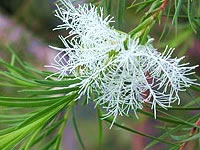Melaleuca alternifolia
English: Tea Tree
Sanskrit/Indian: Tea Tree
Russian: Чайное дерево

General information:
The genus Melaleuca belongs to the myrtle family (Myrtaceae) and includes about 250 species (including the paperbarks, some of which are cultivated as ornamentals). Most Melaleuca species are restricted to Australia. M. alternifolia bears fluffy, white masses of flowers from spring to early summer, and its narrow leaves help distinguish it from the similar species M. linariifolia, which has wider leaves and flattish-spherical fruits.
A tall shrub or small tree up to 7 m high with a bushy crown and papery bark. The hairless leaves are scattered to whorled and are 10-35 mm long by about 1 mm wide. The leaves have prominent oil glands and are rich in aromatic oil. The leaves are borne on a petiole (leaf stalk) of about 1 mm long. The inflorescences are many-flowered spikes, 3-5 cm long, with axes bearing short hairs. The white flowers are solitary, each within a bract, and have petals 2-3 mm long.
Constituents:
The main chemical components of tea tree oil (also referred to as ti-tree oil) are a-pinene, b-pinene, sabinene, myrcene, a-phellandrene, a-terpinene, limonene, 1,8-cineole, y-terpinene, p-cymene, terpinolene, linalool, terpinen-4-ol and a-terpineol.
Benefits:
- The therapeutic properties of tea tree oil are antimicrobial, antiseptic, antiviral, balsamic, bactericide, cicatrisant, expectorant, fungicide, insecticide, stimulant and sudorific.
